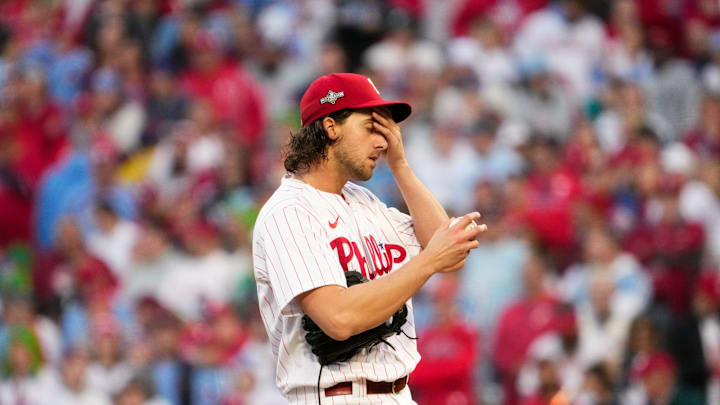The Aaron Nola contract, announced this weekend, provides yet one more illustration of how out of whack with reality baseball’s salary structure is.
A logical salary structure would reward performance, with players who are likely to be the best-performing earning top-end salaries ... but that is not the baseball structure.
The baseball structure pays players based on two elements, neither of which is performance-driven. The first is simple seniority; more experienced players earn more, even if they are predictably less efficient producers of wins than younger players.
The second factor is the free enterprise system. Irrespective of his win-producing capability, what’s it going to take to sign the player?
Nola signed a seven-year, $172 million contract to return to the Phillies. Details have not yet been released, but that works out to about $24.5 million per season for the life of the contract.
And that makes this a fair question: what are the chances of Aaron Nola producing $24.5 million per season in value or the Phillies in 2024?
(Understand that we are talking here only about on-field value. Some players (and Nola may be one of them) also have marketing value, that being the number of paying customers they attract, uniform jerseys they sell, or other commercial revenue they generate.)
To estimate the on-field value Nola is likely to produce going forward, we first have to attach some dollar figure to what he has done. That’s entirely doable.
During the 2023 season, Nola was one of 118 pitchers who made at least 20 starts. For lack of a better term, we can classify these 118 as "rotation starters."
There was a wide variation in the salaries of these 118, all the way from the major league minimum to the $43.333 million pulled down by Max Scherzer and Justin Verlander. The average, however, worked out to $7.89 million. Nola earned about twice that average, $16 million.
Those 118 rotation starters produced an average of 2.04 WAR for their teams. Again there was a wide spread, from Adam Wainwright’s -2.0 in St. Louis to Gerrit Cole’s +7.4 for the Yankees.
But it’s the broad 2.04 WAR average we’re interested in. Put that up against the $7.89 million average salary and we can assert that the baseball market assesses each WAR produced by a major league pitcher to be worth about $3.867 million in salary.
And that means Nola’s 2023 performance (+2.1 WAR in 32 starts) had an actual market value of $8.12 million based on the average performance of all rotation starters.
He was, in other words, slightly better than average. The record shows that. He had a 2.1 WAR against a field average of 2.04. His ERA was 4.06 against an MLB average of 4.33. His ERA+, on a scale where 100 equals the league average, was 96. All these figures describe a garden variety major league rotation starter.
That’s what Nola, at age 30, has become.
Yet his new contract pays Nola as an elite rotation starter. Of those 118 pitchers who made at least 20 starts in 2023, only Verlander, Scherzer, Cole, Chris Sale, Marcus Stroman and Yu Darvish were paid more than the average annual value of the deal Nola just signed (his teammate, Zack Wheeler, was paid $24.5 million).
Since we’ve already established that 1.0 WAR is worth $3.867 million in rotation starter performance, Nola would have to generate a little better than 6.0 WAR to return in value what he will draw in pay. In 2023, Cole (7.4) was the only pitcher to surpass 6.0 WAR.
In fairness to Nola, he came close to that level of production as recently as 2022, hitting 5.9 WAR. But that represented by far his best season since 2018. Over his five most recent seasons, Nola’s average WAR has been 3.26, translating to a $12.5 million value. And, as a general rule, pitcher performance declines as he moves into his 30s.
It’s still possible, of course, for the marketing/promotional value of this contract to justify its existence. But the likelihood of Nola justifying it by his on-field performance? That’s not going to happen.
